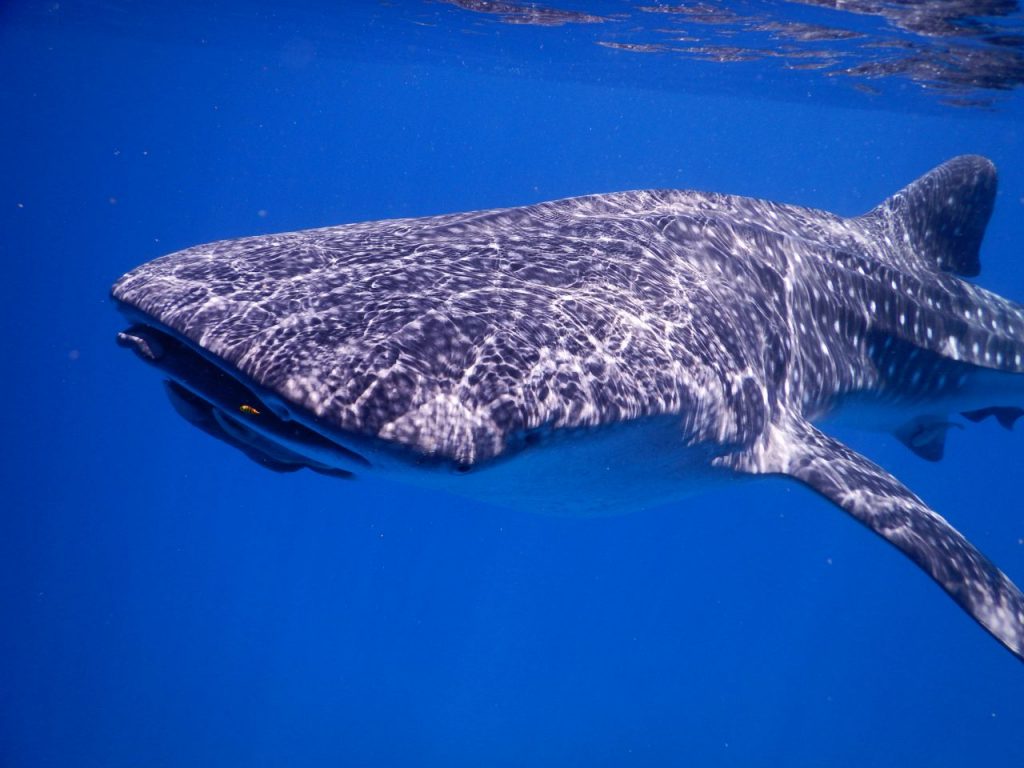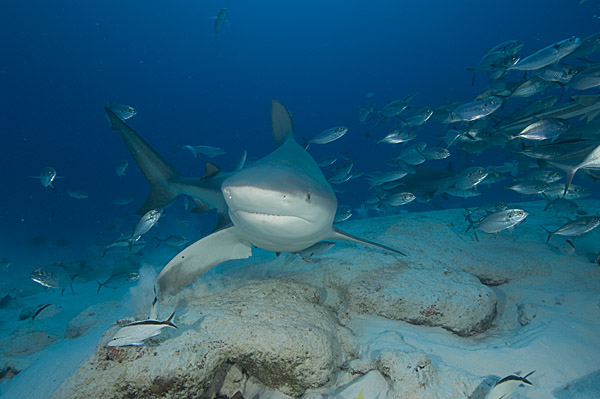
For many people sharks are scary monsters and jumping into the water, known for shark sightings, might sound like a crazy thing to do. Not so for scuba divers. To see a shark, is the highlight on every dive. Many divers are becoming addicted swimming with these perfectly adapted and gracious animals, patrolling our oceans for 420 million years. Unfortunately, less and less, as humans are killing them in the hundres of thousands every year. Divers go on special trips to dive with sharks and shark diving destinations can generate income for the local population and change them from shark killers to shark guardians.
The waters around Coiba and the surrounding area (Gulf of Chiriqui, Gulf of Montijo) are home to more than 30 shark species and a nursery for juvenile Hammerhead sharks. Seeing sharks on your dives with us is a pretty sure bet – ask us what you might see and when.
Scuba Coiba is respecting sharks in their natural environment and will not interfere with their behavior by feeding sharks. As a diver you have a responsibility towards sharks and understand the basic10 Do’s and Don’ts.
It is also important to understand, that a shark diver needs to have good buoyancy skills and be a “calm diver” if you want to be close and want them to stay close, just cruising around you. You also should be able to slowly and calmly move in currents and hold on to rocks, if necessary, to stabilize a non-intrusive behavior without scaring them away, converting the ocean into a jacuzzi, blowing a constant stream of air bubbles into the water. The safest place is on the bottom, sharks hunt in the open or towards the surface. Stay COOL! Panic ascends are the wrong way to get a distance.

I can’t stress enough the need to gain as much knowledge as possible about the animals and their environment. To go into the water without at least a basic idea of how the sharks are likely to react is foolhardy to say the least. You may feel that the operator’s knowledge is sufficient and that you just tag along, is not enough.
So:
1. Get educated!
Ask what species of sharks you are likely to see. Knowing if an area is frequented by white tip reef sharks or bull sharks may make a big difference to how alert you feel you need to be on the dive. Learn about the different sharks, you might encounter.
Find out how the sharks in the area normally respond to divers. Most free swimming sharks will disappear the minute they see a noisy, bubble blowing diver heading their way but some sharks are more curious. Occasionally sharks like to wander up to divers and give them a closer look. Being buzzed or even brushed by a shark does not necessarily mean that you are about to become lunch. We are not a part of their normal food chain and they are no serial killers!
Ask if bait will be used or if any member of the dive group is planning to spear fish. Aggressive behavior is significantly increased in the presence of struggling fish or when blood and other juices are in the water. Make sure with whom you go and what their plan is, before you join.
Find out if the sharks in the area are territorial. Sharks may respond to divers as threats to territory and defensively attack.
2. Dress appropriately
As a rule of thumb, tropical sharks are mainly fish eaters and as such are attracted to bright and shiny objects. Therefore, it would seem logical that a neon yellow wetsuit would attract the attention of sharks looking for a meal. In shark diving circles neon yellow has actually been given the nickname of “yum yum yellow”. Other bright colours may also have the same effect so if you’re planning on regularly putting yourself in the presence of tropical fish eating sharks it may be a good idea to tone down your fashion statement and choose a more muted color or black. Bear in mind that thousands of divers swim with tropical sharks every day wearing all manner of clothing from bikinis to camouflaged full body dive skins and the incidence of attack is extremely low.
If you have bright metal objects such as reels or dive knifes attached to the outside of your BC try to stash them out of sight in a pocket or replace them with darker colored alternatives.
Full suits are better than shorty wetsuits. Don’t expose your hands and other parts of skin that a shark can focus on or mistake for a fish. Even if you have dark skin it’s a good idea to cover up. A lot of injury can occur from the brush of a shark’s sandpaper like skin.
Lastly, fins tend to be prime targets for bites. This has more likely to do with their movements and exposed position rather than color but white, silver, or bright fins should probably be avoided.
3. Avoid erratic movements
Sharks are able to pick up on disturbances in their environment. They are looking for the tell tale signature of a wounded fish or other animal. Once they find one they carry out their civic duty and remove the wounded creature from the gene pool. Thrashing around in the water may mimic the vibrations sent out by a wounded fish and/or may replicate the movements of a feeding shark. Either way, slow, rhythmic fin strokes are more likely to be ignored. Keep your hands to your body (you also might use gloves), moving fingers with naked skin might look like tasty fishfingers. Good buoyancy is also important. Crashing into the reef or struggling to stay down could generate interest or may work in reverse and drive away sharks that you were hoping would stay around.
4. Look but don’t touch
The best way to get bitten by a shark is to grab it by the tail or any other part of its anatomy. You wouldn’t think this needs putting into print but a surprising amount of shark bites are the direct result of divers trying to man handle otherwise docile creatures. Joe shark diver sees a lazy white tip reef shark’s tail protruding from under the reef and thinks that if he gives it a little poke or tug the lazy shark will shift into a position where Joe can get a better look at its head. He grabs the shark’s tail and before he has time to register exactly what has happened, he looks down to find a shark jaw wrapped around his wrist. Also reef sharks have rows of sharp little teeth and once Joe is finally released (which sometimes doesn’t happen until he is literally dragged out of the water) Joe gets to spend the rest of his holiday at the very least with a bandaged arm. Don’t be Joe Shark Diver. Sharks are extremely flexible and explosively fast. Whale Sharks have no teeth, but they have a 5 tons heavy tail fin; you don’t what to get slapped with it.
Rays – the shark’s close cousins – usually remain very docile if you approach them slowly until their personal space is encroached upon and then they finally either bolt or slowly lift off the bottom and relocate a few meters away. The best way to get near them is to move in close to the sea bed. Rays feel more threatened when approached from above.
In rays the two defense mechanisms that a diver needs to be aware of are: the stingray’s tail barb, and the electric rays’ ability to shock.
5. Stay away from the chum
Sharks that come to a shark feed are not there to socialize. They want food and if you’re between them and dinner you’re in the wrong place at the wrong time. Keep your distance from any bait or food scraps and if the current is moving a chum slick away from the area make sure that you are positioned off to the side or up stream.
Having watched the shark’s behavior for some time you may feel confident about moving in for better pictures or a better look. Remember that if the current is running and you are down stream any sharks that are swimming up to the bait may think that those delicious odors are emanating from you. Now you’re stuck in a position where a shark is coming toward you and you are drifting into it. As it’s very hard to swim against even a mild current you probably now have to turn around to make headway against it to get back up stream which puts you with your back to the approaching shark. A better course of action is to swim sideways until clear of the chum slick at which point you can kick up current without looking like a fleeing wounded animal.
. We are not feeding sharks, but you might end up one day on a boat with other people fishing and cleaning the fish……so we wanted to mention it.
6. Get underwater
Floating at the surface in the presence of sharks sends the wrong message. You want to descend as soon as you can for a few reasons:
Firstly, a body floating at the surface is high on the list of desirable objects for a shark to explore. In the ocean dead things float.
Secondly, if your head is above water you are effectively blind to the movements of any sharks underwater.
Thirdly, a positively buoyant diver’s actions are far more limited. It takes time to become negative and descend out of trouble and swimming at the surface in dive gear looks an awful lot like a thrashing animal.
7. Avoid dives planned with deco stops
If a shark is getting too curious it might be a calming thought, that you always can swim up directly to the surface and hop into the boat without making a necessary 12 minute deco stop close to the surface with Bruce blinking his teeth beneath you.
8. Read the sharks
Some sharks regardless of food stimulus may become aggressive towards divers. Any type of posturing is a bad sign. The threat display of Grey reef sharks has been well documented. This consists of exaggerated swimming motions, back arching, raising of the snout, lowering of the pectoral fins, and head swinging. Not all sharks will give you these visual cues but most have a pretty similar behavior. The message is a clear one: BACK OFF! Hopefully the diver will notice the posturing and move away before the shark takes its next defensive strategy which is often to attack. The most common scenario in which this situation occurs is when a shark is cornered. Try to always give sharks an escape route and move out of his space – calmly, slowly, keeping an eye contact with your new acquaintance.
It may be tempting to want to photograph posturing behavior but this has proven to be the downfall of numerous divers in the past. A camera flash or only sunlight reflecting in your camera lens is often the catalyst that brings on the final attack. Even bringing a camera up to eye level may be enough to push a shark over the edge and it’s important to remember that no matter how ready you think you are, if a shark attacks at speed you are unlikely to be able to block the attack in time.
Be aware that some species are territorial, for example reef sharks but also bull sharks. Respect their territory.

9. Be a responsible participant
We have come a long way since the early days of Jacques Cousteau pitting himself against the monsters of the sea. The survival of the sharks that cruise today’s oceans hangs in the balance. There is no excuse for harming any shark or even interrupting important behaviors such as mating or birthing. If you feel that a shark diving situation may require the use of a power head or other weapon for protection then the dive should not take place and you are not a responsible shark diver.
It is also important to protect the fragile environment that sharks and rays inhabit. “Getting the shot” is secondary to protecting the reef regardless of what the subject is. Always practice good buoyancy skills and if the situation calls for you to crouch inconspicuously on the sea floor find a barren spot that will not damage any corals or other marine creatures. That group of orange sponges may make for a better photo location but not at the expense of the surrounding corals.
Diving with sharks can be a fun and highly rewarding activity but this becomes hollow and selfish enjoyment if you in any way harm the animals you came to see.
10. Sign up for a Shark Conversation Specialty course, including 2 dives with us

This post is a mixture of a summarize of a post by Andy Murch of www.bigfishexpeditions.com posted on www.elasmodiver.com adapted to our area
